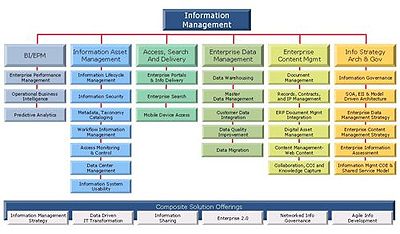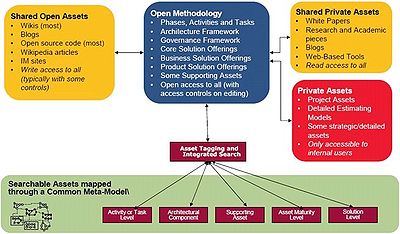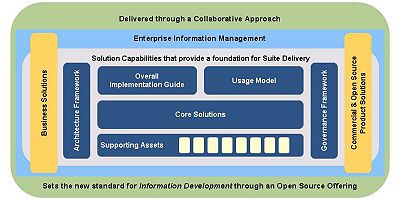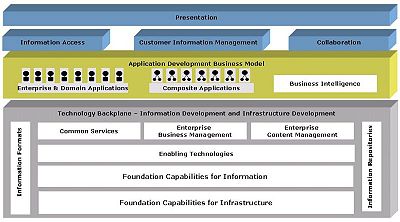
MIKE2.0 Methodology
Encyclopedia

Open source
The term open source describes practices in production and development that promote access to the end product's source materials. Some consider open source a philosophy, others consider it a pragmatic methodology...
delivery methodology for Enterprise information management
Enterprise information management
Enterprise Information Management is a particular field of interest within information technology area. It specializes in finding solutions for optimal use of information within organizations, for instance to support decision-making processes or day-to-day operations that require the availability...
. MIKE2.0 was released to the public in December, 2006, by BearingPoint
BearingPoint
BearingPoint is an independent management and technology consulting firm. Following a post-bankruptcy management buyout in August 2009, BearingPoint has been operated by its European management team and is organized as a partnership...
, a management and technology consulting company, under the Creative Commons
Creative Commons
Creative Commons is a non-profit organization headquartered in Mountain View, California, United States devoted to expanding the range of creative works available for others to build upon legally and to share. The organization has released several copyright-licenses known as Creative Commons...
Attribution License
Creative Commons licenses
Creative Commons licenses are several copyright licenses that allow the distribution of copyrighted works. The licenses differ by several combinations that condition the terms of distribution. They were initially released on December 16, 2002 by Creative Commons, a U.S...
. The project is now run by the MIKE2.0 Governance Association
The methodology provides a comprehensive framework for Information Management
Information management
Information management is the collection and management of information from one or more sources and the distribution of that information to one or more audiences. This sometimes involves those who have a stake in, or a right to that information...
, including:
- Information GovernanceData governanceData governance is an emerging discipline with an evolving definition. The discipline embodies a convergence of data quality, data management, data policies, business process management, and risk management surrounding the handling of data in an organization...
- Data Quality ImprovementData qualityData are of high quality "if they are fit for their intended uses in operations, decision making and planning" . Alternatively, the data are deemed of high quality if they correctly represent the real-world construct to which they refer...
- Data IntegrationData integrationData integration involves combining data residing in different sources and providing users with a unified view of these data.This process becomes significant in a variety of situations, which include both commercial and scientific domains...
- Data MigrationData migrationData migration is the process of transferring data between storage types, formats, or computer systems. Data migration is usually performed programmatically to achieve an automated migration, freeing up human resources from tedious tasks...
- Data Warehousing
- Master Data ManagementMaster Data ManagementIn computing, master data management comprises a set of processes and tools that consistently defines and manages the non-transactional data entities of an organization...
- Data-driven IT TransformationIT TransformationIT Transformation is the wholesale changing of an organization's technology systems. It is a term that typically applies more to large, complex organisations than smaller entities...
- Enterprise SearchEnterprise searchEnterprise search is the practice of making content from multiple enterprise-type sources, such as databases and intranets, searchable to a defined audience.-Enterprise search summary:...
- Enterprise 2.0Enterprise 2.0Enterprise 2.0 is the use of "Web 2.0" technologies within an organization to enable or streamline business processes while enhancing collaboration - connecting people through the use of social-media tools. Enterprise 2.0 aims to help employees, customers and suppliers collaborate, share, and...
In summary, MIKE2.0 is a framework for Information Management best practices - linked into common business issues and technology-specific solutions. Its scope covers the complete information supply chain within an organisation: from how it is created, accessed, presented and used in decision-making to how it is kept secure, stored and destroyed.
Key Concepts of MIKE2.0
A few concepts introduced in MIKE2.0 are important to explaining the purpose of the framework and how it can be applied.Information Development
While initially focused around structured data, the goal of MIKE2.0 is to provide a comprehensive methodology for any type of Information DevelopmentInformation Development
Information Development is a peer-reviewed academic journal that publishes papers in the field of Information Science. The journal's editor is J. Stephen Parker...
. Information Development is about:
- Driving an overall approach through an organization's Information Strategy
- Enabling people with the right skills to build and manage new information systems while creating a culture of information excellence
- Moving to a new organisational model that delivers an improved information management competency
- Improving processes around information compliance, policies, practices and measurement
- Delivering contemporary technology solutions that meet the needs of highly federated organizations
The MIKE2.0 approach is based on the premise that traditional software delivery has under-focused on the information management. The goal of MIKE2.0 is to create a new competency, specifically for managing information
,
Integrated Content Repository

.
This repository is a federated hub of shared assets from the internet, the MIKE2.0 open standard and content held internally within an organization. Using this concept, organizations can create mashups
Mashup (digital)
A digital mashup usually is in reference to:1. Digital media content containing any or all of text, graphics, audio, video and animation drawn from pre-existing sources, to create a new derivative work...
to the MIKE2.0 standard and the best information management
assets on the web. Although they are not required to share any of their assets with the open source community, they are encouraged to contribute. This approach is generally referred to as Governance 2.0 as part of the solution.
The content repository architecture is based on using wiki-pages created in MIKE2.0, assets that are linked from other sites using a social bookmarking tools and common tagging and extensions that allows users to create mashups into their organization.
Open Methodology Framework
MIKE2.0 claims to be the world’s first open and collaborative methodology. It proposes to be an approach which sits between a completely open Wikipedia-style model and a more rigorous development approach seen with software development. The collaborative technology, the structure of the content model and a number of content governance articles are used to enable this concept. The methodology states that this model is likely to evolve over time
.
Content Model for MIKE2.0

Solution Offerings
Solutions relate to business and technology problems related to information management. Solution Offerings tend to focus on a certain type of problem as opposed to being generalized for information management like the Overall Implementation Guide. Solution Offerings are mapped to Activities in the Overall Implementation Guide.There are multiple types of Solutions that make up the MIKE2.0 Methodology:
- Core Solution Offerings are logical best practices used to common problems in information management.
- Business Solution Offerings are applied to common business problems for which information management practices are a key success factor.
- Product Solution Offerings provide integrated approaches to solving issues from a technology-specific perspective.
The SAFE Architecture and Information Governance Solution Offering are foundational aspects of MIKE2.0 that are also Solution Offerings.
SAFE Architecture

Information Governance
Information Governance is a Solution Offering for MIKE2.0 and also a foundation of the overall approach. As the goal of MIKE2.0 is to provide a common competency for information management, the governance as aspects of the approach are particularly important. The governance model provides assessment tools, information standards, organizational structures and roles and responsibilities in relation to managing information assets. The Governance 2.0 approach introduced in MIKE2.0 is the enhancement of this approach with Enterprise 2.0 techniques and technologies.Solution Capabilities
Solution Capabilities are the assets that bring together the MIKE2.0 Methodology by proving the foundation of activities, reusable assets and common architecture and governance models.Overall Task List
- Overview and Key Concepts frame the overall approach as well as the rationale for why MIKE2.0 was created.
- The Overall Task List is a project management and project implementation methodology consisting of 5 Phases, activities for each phase, tasks for each activity and inputs/outputs for each task. These are:
- Phase 1 - Business Assessment and Strategy Definition Blueprint
- Phase 2 - Technology Assessment and Selection Blueprint
- Phase 3 - Information Management Roadmap and Foundation Activities
- Phase 4 - Design Increment
- Phase 5 - Incremental Development, Testing, Deployment and Improvement
The task list is underpinned by the Information Development approach and tightly integrated with SAFE Architecture.
- Usage Models show how the different tasks are applied for different solutions. Usage models use an indicator approach to show the relevance of an activity.
Supporting Assets
Supporting Assets complement the overall methodology with:- Tools and technique papers (such as Information Maturity Quickscan)
- Deliverable templates
- Capability statements
- Software assets
- Other tools and guides
Supporting Assets are typically the lowest-level assets of the overall approach.
Collaboration Environment

OmCollab
omCollab is a software product completely built on open source software and is used for collaboration within organisations or on the internet. It provides a web portal environment to create, share and search Microsoft Office content, files, shared bookmarks, blog posts and wiki articles across the...
, an open source collaboration product that provides the following capabilities:
- A WikiWikiA wiki is a website that allows the creation and editing of any number of interlinked web pages via a web browser using a simplified markup language or a WYSIWYG text editor. Wikis are typically powered by wiki software and are often used collaboratively by multiple users. Examples include...
to collaboratively create and share content (based on the same MediaWikiMediaWikiMediaWiki is a popular free web-based wiki software application. Developed by the Wikimedia Foundation, it is used to run all of its projects, including Wikipedia, Wiktionary and Wikinews. Numerous other wikis around the world also use it to power their websites...
software that powers WikipediaWikipediaWikipedia is a free, web-based, collaborative, multilingual encyclopedia project supported by the non-profit Wikimedia Foundation. Its 20 million articles have been written collaboratively by volunteers around the world. Almost all of its articles can be edited by anyone with access to the site,...
) - Blogs to publish individual or group-based information (based on WordpressWordPressWordPress is a free and open source blogging tool and publishing platform powered by PHP and MySQL. It is often customized into a content management system . It has many features including a plug-in architecture and a template system. WordPress is used by over 14.7% of Alexa Internet's "top 1...
) - Social BookmarkingSocial bookmarkingSocial bookmarking is a method for Internet users to organize, store, manage and search for bookmarks of resources online. Unlike file sharing, the resources themselves aren't shared, merely bookmarks that reference them....
for storing, sharing and discovering web bookmarks - Social Networking for the MIKE2.0 community to store basic profile information and to interact with one another.
- Tag (metadata)Tag (metadata)In online computer systems terminology, a tag is a non-hierarchical keyword or term assigned to a piece of information . This kind of metadata helps describe an item and allows it to be found again by browsing or searching...
and categoriesCategorizationCategorization is the process in which ideas and objects are recognized, differentiated and understood. Categorization implies that objects are grouped into categories, usually for some specific purpose. Ideally, a category illuminates a relationship between the subjects and objects of knowledge...
are used to classify articles, blogs and bookmarks into a common taxonomy. MIKE2.0 brings these two concepts together in the bookmarking component. - Techniques and technologies to mashupMashup (web application hybrid)In Web development, a mashup is a Web page or application that uses and combines data, presentation or functionality from two or more sources to create new services...
to MIKE2.0, to build integrated solutions based on open content and internally held assets - SearchSearch engineA search engine is an information retrieval system designed to help find information stored on a computer system. The search results are usually presented in a list and are commonly called hits. Search engines help to minimize the time required to find information and the amount of information...
for users to discover content across federated repositories. MIKE2.0 uses Google Custom Search. - A rich user interface with advanced navigational components an integrated skin and single sign on to provide common look and feel across the platform
- An Open Methodology Compliance (OMC) capability to link an organisation into the MIKE2.0 open standard
The MIKE2.0 Methodology uses a foundation of open source
Open source
The term open source describes practices in production and development that promote access to the end product's source materials. Some consider open source a philosophy, others consider it a pragmatic methodology...
technologies with a number of extensions and customizations. The overall product is referred to as "omCollab" and is released in its entirety to the open source community
as part of the project.
Impact on the Information Management Community
Since its release to the open source community, MIKE2.0 has been referenced a number of times as a case study on Web 2.0 communitiesWeb 2.0
The term Web 2.0 is associated with web applications that facilitate participatory information sharing, interoperability, user-centered design, and collaboration on the World Wide Web...
, including a recently released book Groundswell
Groundswell (book)
Groundswell is a book by Forrester Research executives Charlene Li and Josh Bernoff that focuses on how companies can take advantage of emerging social technologies.It was published in 2008 by Harvard Business Press...
.
The content has also been taught through a number of online webinars and as a part of a Melbourne University lecture series on Data Warehousing
,
of which some of the training materials are available on the MIKE2.0 site. AIIM have based their
Enterprise 2.0
Enterprise 2.0
Enterprise 2.0 is the use of "Web 2.0" technologies within an organization to enable or streamline business processes while enhancing collaboration - connecting people through the use of social-media tools. Enterprise 2.0 aims to help employees, customers and suppliers collaborate, share, and...
specialist certification program around the MIKE2.0 Solution Offering and use the overall approach as a training case study.
,
External links
- MIKE2.0 Homepage
- MIKE2.0 within the MDM-CDI Ecoystem, initially published by Zornes, DM Review
- Taking Data Quality to the Enterprise through Data Governance, presentation at the 2007 Database Grand Conference in Korea on Data Quality Management that presents MIKE2.0 and other Data Quality Methodologies
- Overview from Initiate Systems on Master Data Management, includes an overview on MIKE2.0 as the methodology for implementation

